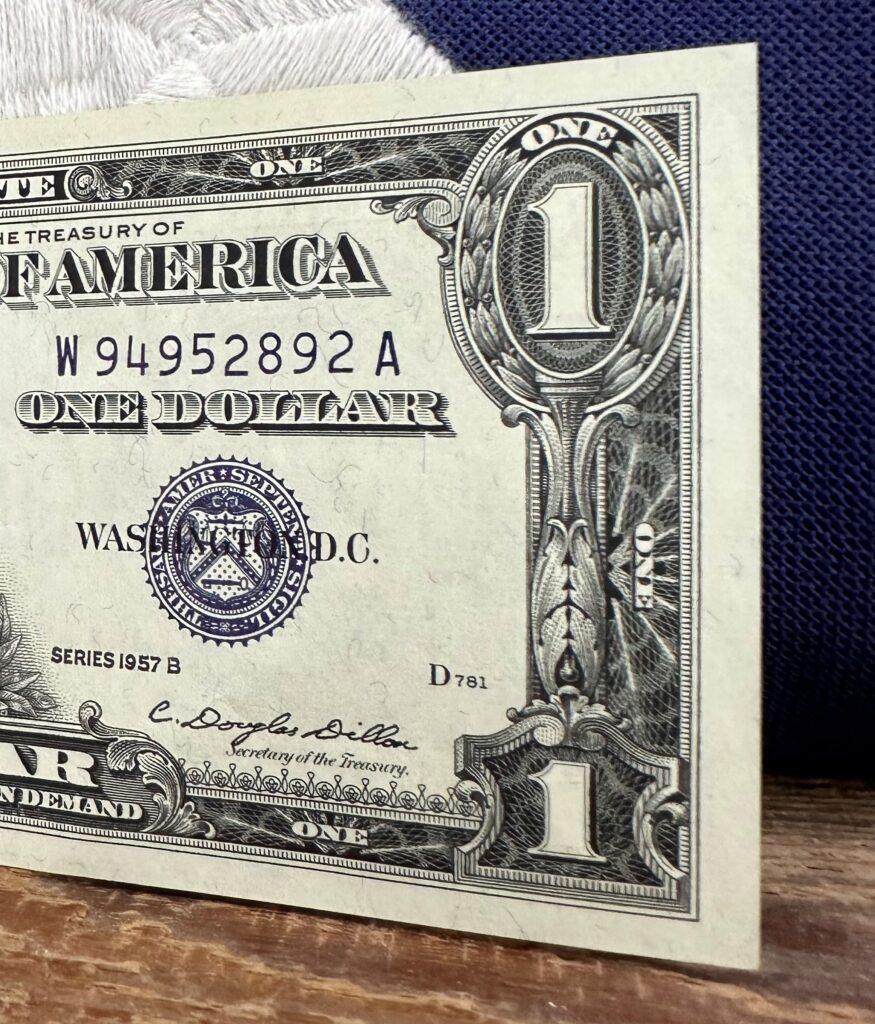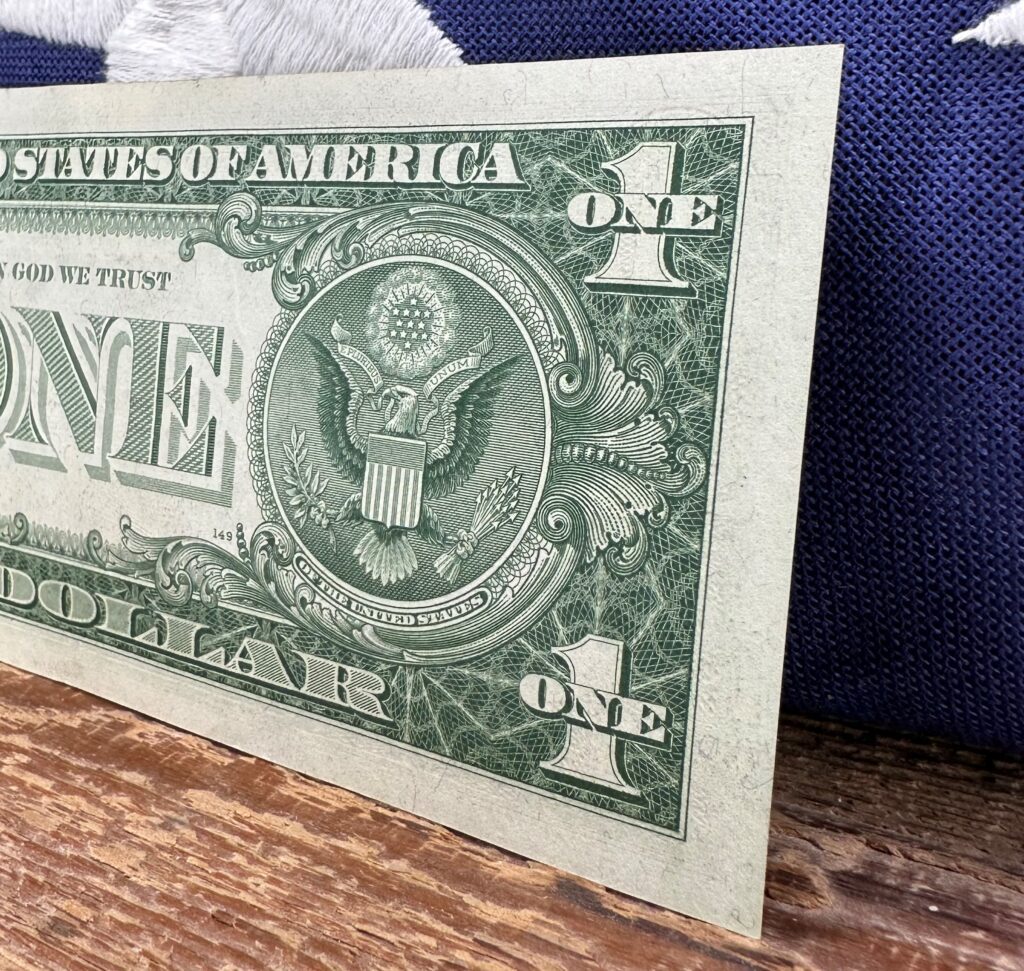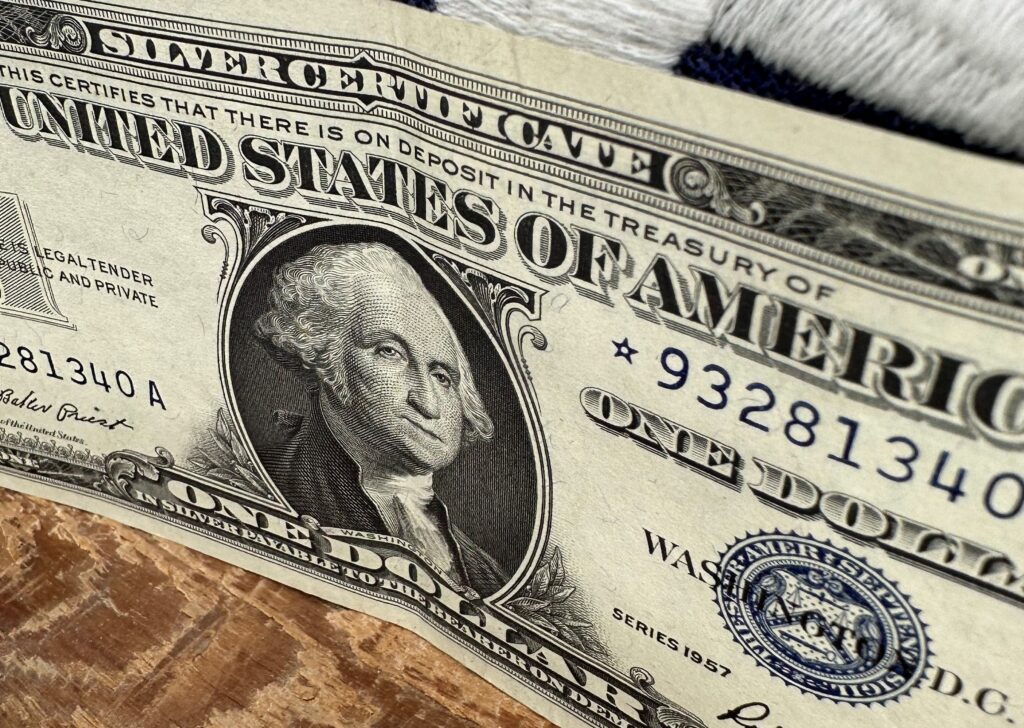The 1957 silver certificate is a sometimes forgotten but essential piece of U.S. currency history.
Produced between 1878 and 1964, silver certificates were a form of U.S. currency that could be redeemed for silver coins at any time.
The 1957 Silver Certificate
The certificates represented an easy way to effectively hold silver without carrying the metal itself. But in the early 1960s, the value of silver rose to the point that silver coins had a higher melt value than face value.
In response, people redeemed their silver certificates in droves and hoarded silver, resulting in a coin shortage nationwide.
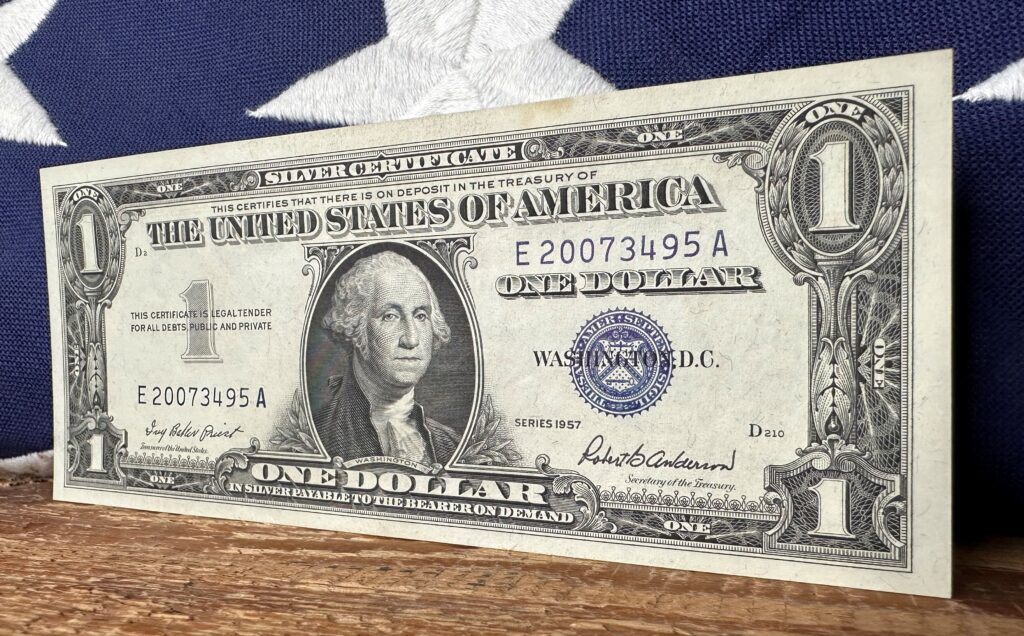
As such, the production of silver certificates stopped in 1963, and by 1968, existing certificates could no longer be redeemed for silver coins.
However, silver certificates were still regarded as legal tender, which means many still appear in circulation.

If you’re unfamiliar with silver certificates, you might be surprised that the 1957 silver certificate looks almost identical to the $1 federal reserve notes we use today.
Experienced collectors do not typically regard 1957 silver certificates as highly collectible, but a crisp uncirculated certificate is an excellent introduction to the hobby if you’re new to numismatics.
Their easy accessibility and low cost make them ideal for starting a collection.
How Much Is a 1957 Silver Certificate Worth?
Even though the 1957 silver certificate is an exciting piece of history, it could be worth more than you may think. Mostly because certificates aren’t necessarily rare:
Approximately 5.3 billion certificates were printed.
There is some variation in value among the notes, but generally speaking, even silver certificates in crisp, uncirculated, or nearly uncirculated condition are only worth about $10-$25.
Certificates in poorer condition are often worth their face value or slightly above.
For the numismatist, a silver certificate’s value is more than its monetary denomination.


1957 Silver Certificate Star Notes
If you’re interested in collecting silver certificates from 1957, you’ll find that discovering different varieties can be plenty of fun.
One of the rarest varieties is the star note. Suppose a silver certificate is marked with a star at the beginning or end of its serial number.
In that case, it means there was some imperfection when the certificate was manufactured.
Of all the silver certificates printed in 1957, only about 11% are star notes, which usually puts them at the upper end of the value spectrum. Most are worth about $20-$30 or a little more.

One Dollar 1957 Silver Certificate Design
Over the history of the silver certificate, it underwent a few different redesigns.
Notably, the 1957 silver certificate, in particular, was the first form of paper money to include the inscription “In God We Trust.”
You’ll want to take note of the words below the portrait of George Washington.
Printed in large letters is “ONE DOLLAR,” but read carefully underneath the heading, and you will see the words, “IN SILVER PAYABLE TO THE BEARER ON DEMAND.”

Just like the gold certificates proved ownership of physical gold, holders of the silver certificate could redeem it for one dollar in silver on demand.
As mentioned, the design of a one-dollar silver certificate from 1957 looks very much like today’s dollar bill, though a few different features set the two apart:
Serial Number
Each certificate has a serial number in blue in two places: above the signature and to the left of George Washington and above the “ONE DOLLAR” inscription to Washington’s right.
No particular serial number is more valuable than the rest.
However, if you find a certificate with a serial number that begins and ends with the letter B, you might find it worth slightly more than average (albeit still less than $50).
Unique serial numbers can also increase the value of a given certificate.
Seals
Each 1957 silver certificate bears a circular blue Treasury seal under the serial number on the right side. Today’s dollar bills still have the Treasury seal printed in the same place, but the seal is green.
Signature
Each silver certificate bears two different signatures, though interestingly enough, in 1957, there were three different signature combinations.
These were categorized into the standard 1957, 1957 A, and 1957 B series.
Certificates from the standard 1957 series include the signatures of Treasury Secretary Robert Bernard Anderson and Treasurer Ivy Baker Priest.

Silver Certificate A Series
Certificates from the A series have the signatures of Treasury Secretary Clarence Douglas Dillon and Treasurer Elizabeth Rudel Smith.
Silver Certificate B Series
Certificates from the B series bear the signatures of the United States of America Government Treasury Secretary Clarence Douglas Dillon and Treasurer Kathryn Elizabeth Granahan.

Blue Seal One Dollar Silver Certificates
You may have seen listings for silver certificates advertise them as “blue-seal one-dollar silver certificates.”
However, silver certificates from many other years also include blue seals, so if you’re looking specifically for a 1957 certificate, check the year before purchase!

Most Valuable 1957 Silver Certificates
Although most silver certificates aren’t worth much, there are a few valuable exceptions.
Below are some examples of certificates that may be worth more than expected:
Very Low Serial Numbers
Silver certificates with single-digit serial numbers (like 00000001) are often more valuable.
Some collectors may also prize those with double-digit or triple-digit serial numbers, but generally speaking, the lower the number, the better.
Low serial numbers possess a fair amount of sentimental value, as they are the first bills produced in a given block, though they can also hold significant monetary value.

One silver certificate with serial number X00000001A was sold in 2005 for $8,050.
A low serial number doesn’t automatically guarantee a high value.
Often, the sentimental or subjective value a bidder places on a silver certificate plays into its sale price, so depending on who’s bidding, a bill with a rare serial number may or may not sell for a high price.
Interesting or Unusual Serial Numbers
Often, collectors like bills that were given uncommon serial numbers.
The most expensive 1957 silver certificate on record is a note with the serial number 88888888. In 2022, the bill sold at auction for an impressive $8,700.

Other certificates with solid-block serial numbers have also sold for large amounts.
One with the serial number 77777777 was sold in 2019 for $2,040, and in 2017, a 1957 silver certificate with the serial number 44444444 sold for $940.
Packs of Star Notes With Sequential Serial Numbers
Because star notes are relatively rare compared to other 1957 silver certificates, an entire pack of them is a great find!
Sequential serial numbers also increase the value of any collection of paper money. One original package of 100 1963 silver certificates sold for $2,880 in 2023.
That number might seem somewhat low — after all, a series of rarer bills could sell for thousands of dollars.
But thanks to the abundance of silver certificates, auction prices tend to be comparatively low, even for rare finds.

Small-Size 1957 Silver Certificate One Dollar Bill Values
If you’re looking for more specific values, here’s a list of value estimates by series from Professional Coin Grading Service (PCGS) –
- 1957 (Priest-Anderson signature): $20
- 1957-A (Smith-Dillion signature): $15
- 1957-B (Granahan-Dillion signature): $10
Values for star notes from the same series in GEM uncirculated condition –
- 1957 (Priest-Anderson signature): $20
- 1957-A (Smith-Dillion signature): $25
- 1957-B (Granahan-Dillion signature): $30
These particular value estimates are for bills graded Choice UNC PPQ63, which stands for “choice uncirculated premium paper quality,” with a number grade of 63 (out of a range of 1-70).
In other words, these values are for bills in excellent (but not necessarily perfect) condition.
Of course, as you saw above, it’s possible to find 1957 silver certificates worth considerably more.
Remember that these high-value bills are typically the exception, not the rule.
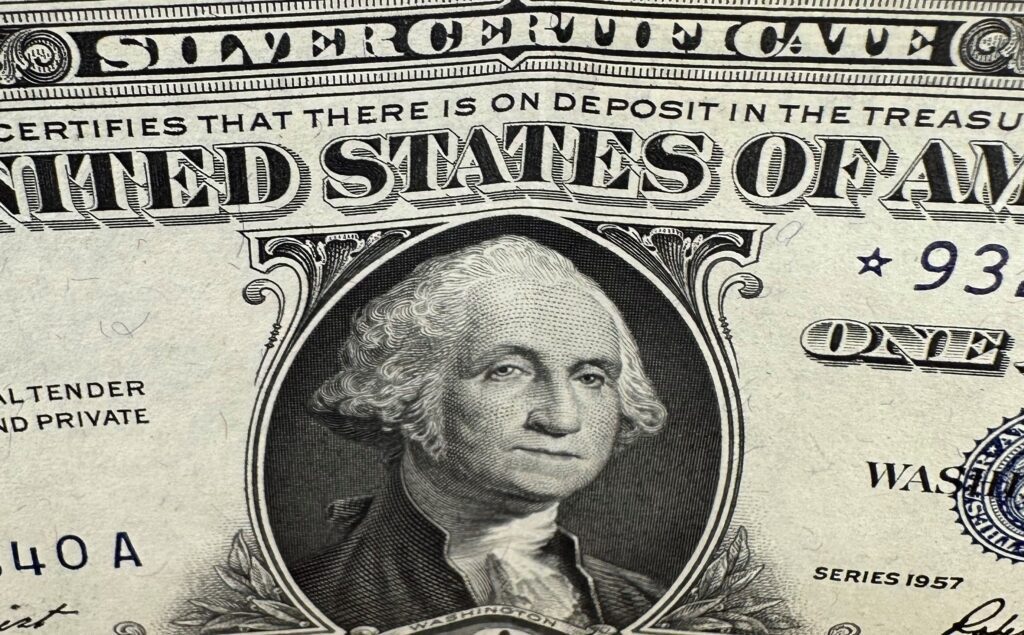
1957 Silver Certificate Errors
As with any coin or paper money, 1957 silver certificates with errors sometimes appear. In some cases, error notes are valuable; if the bill has several errors, its value may increase even more.
Here are some interesting errors you can be on the lookout for:
Mismatched Serial Numbers
Mismatched serial numbers often add considerable value to any form of paper money. Just check to see if they match!
Since silver certificates have the serial number printed twice on the obverse of the note, it’s easy to identify such an error.
If you can find a group of certificates with mismatched serial numbers, you can sell them for thousands. In 2019, 20 sequential error notes sold for $13,200.

Valuing error banknotes can be tricky, so before you get excited about having a valuable error note, you should check with an appraiser or paper money expert to see how much it may be worth.
A PMG-graded bill in AU55 very fine condition with mismatched serial numbers, is selling for $450 on eBay.
Stuck Digit Error
An interesting fallacy to spot is a stuck digit error, which occurs when there’s an issue with printing. The “stuck” digit appears below the rest of the serial number.
A silver certificate stuck digit error may not be too terribly valuable on its own, but if it appears alongside another error, it may substantially increase the bill’s value.
Discovering the World of Silver Certificates
If you enjoy collecting rare coins, American Eagle silver dollars, silver bullion, and paper money, you already know that monetary value isn’t everything.
Silver certificates from 1957 may not be the most collectible bills in the world, but they’re easy to find and won’t break the bank.
Additionally, when you add one to your collection, you’ll own a unique piece of American history. Visit your local rare coin shop or any online coin company for your very own $1 dollar silver certificate.

There Is Much More to Learn About The 1957 One Dollar Certificate –
Now We Know That –
- Silver certificates were an essential part of commerce in U.S. history because they made it easy to own silver without hauling the precious metal around in your pocket all day long.
- When the price of silver skyrocketed in the early 1960s, people hoarded the metal. Very few people were interested in silver certificates when they wanted to own the scarce and valuable metal backing the paper. Production of silver certificates ended in 1963.
- More than 5.3 billion silver certificates were created, and now rare errors and notes in great condition are highly valuable to collectors.
A Few More Little Known Facts About the 1957 One Dollar Certificate –
- Two separate acts issued by Congress in 1878 and 1886 authorized the creation of silver certificates. Although the sizes, designs, and denomination amounts varied over the years, their purpose was the same – to redeem for on-demand silver.
- You can no longer exchange 1957 silver certificates for actual silver. Since 1968 they can only be exchanged for Federal Reserve Notes.
- The very first paper currency printed using the “In God We Trust” motto was the 1957 silver certificate.
- The biggest factor for your 1957 1 dollar bill worth is the condition. Notes receiving a high grade on the Sheldon scale of one to 70 could be much more valuable than non-graded certificates.
Continue Your Rare Coin and Currency Collecting Journey –
- I want to sell my coins online, but where?
- What is the value of my rare coins and paper currency?
- How many different types of U.S. Coins are there?

